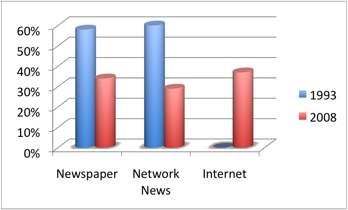 As print and technology products in education blend together the distinctions between textbook publishers and ed-tech providers are blurring in some very interesting ways.
As print and technology products in education blend together the distinctions between textbook publishers and ed-tech providers are blurring in some very interesting ways.
A recent report by the Pew Research Center for the People and the Press on how on-line and traditional news media are blending together raises some provocative questions for how this will play out in education.
Several years ago schools bought technology and print products from completely different budgets and with very different purchase processes. As educators have become more sophisticated about what technology can do and what it can’t do they are demanding that providers blend the best of technology with the best of print.
We are already seeing this play out in how people consume news and the Pew study sheds some valuable light on this topic. Here are four big ideas that came out of it for me.
1. The Integrators – the 23% of the population who are actively using traditional and new media – tend to be affluent, highly educated, and middle aged. They grew up with traditional media and are comfortable with it, but due to their interest in politics and sports are using on-line media to dig deeper and in more personalized ways than the general public. This group corresponds to the teaching corps in this country. If you want to sell instructional products to schools teachers are the gatekeepers – if they won’t use it in their classroom you have no sustainable business. To reach their comfort zone you will need to blend the old and the new.
2. Net-Newsers – this is the most affluent and best educated group but also the youngest. 30% of them watch news clips on the web – only 18% of them watch the evening news on TV. They also are the heaviest consumers of news – digging in all day long. This group corresponds to students. While you may produce blended products in order to sell to teachers you need to make your on-line offerings rich enough to satisfy the younger users – it will be their primary interface to the content.
3. The use of print will decline – but not go away. The numbers in the report about newspaper usage are a wake up call to textbook publishers. In 1993 58% of the population read the paper daily, by 2008 this was down to 34%. Nightly network news saw an even greater drop – it went from 60% down to 29%. Meanwhile on-line went from 0% in 1993 to 37% in 2008.

The pied pipers of ed-tech who sing sweet songs about the end of print are going to have a wait a long time for that to happen. But – I do believe that just as newspapers and magazines are getting thinner and thinner our textbooks will slim down as more of the content moves on-line. The rise of the Kindle and other reading devices may also spark an evolution in how we consume “print” in the same way the youTube is changing how we consume video.
4. Politics and sports are a key drivers of on-line usage. Both the Integrators and the Net-Newsers valued the on-line tools for the insights into politics and sports. Social studies is probably the area where having on-line content that changes on a daily or weekly basis has the most value. Districts that want to bring parents into their own web resources might stress school sports – something that not even the most dedicated local paper can do for every school in their area.
Publishers can learn valuable lessons about how this transition is likely to play out in schools by watching what has happened in the news arena. This study is worth a look if you are interested in this topic.
Related Posts
Textbooks vs. Education Technology – Clash of Paradigms
The Future of Education Publishing
 The Education Business Blog
The Education Business Blog

